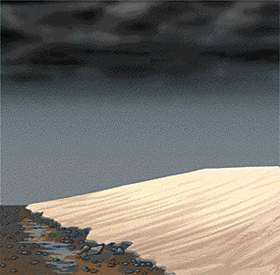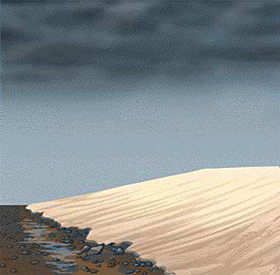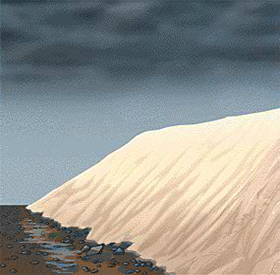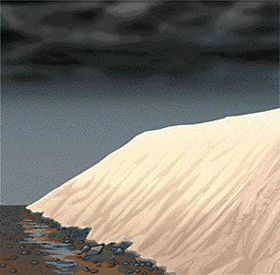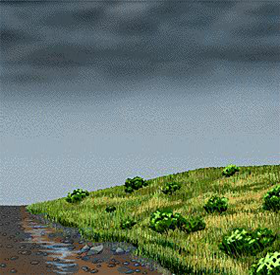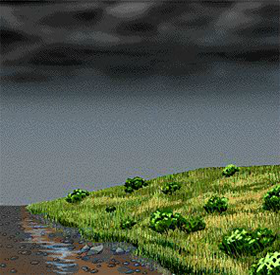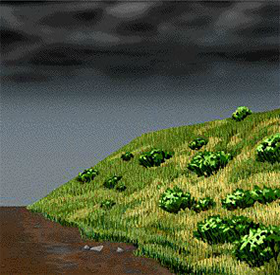VIRTUAL LABS
X
Water Erosion and Deposition
How do certain factors affect the erosion of soil by water?
Water erosion is the process by which water wears away Earth's surface materials and moves them from one location to another. When rain falls it soaks into the ground, evaporates, or becomes runoff. Runoff is the major cause of water erosion. Factors that affect runoff include the amount of rain, the time span over which rain falls, the slope of the land, and the amount of vegetation on the land. The effects of erosion may be immediate, or they may take years to become apparent.
There are different types of water erosion. Rill erosion begins when a small stream forms during a heavy rain. The stream carries away vegetation and soil. If a stream frequently flows along the same channel, rill erosion can evolve into gully erosion. In gully erosion, rill channels become wider and deeper gullies.
Water can also erode without forming a channel. For example, when rain falls on a flat area, water accumulates and loosens and displaces surface soil. Sheet erosion occurs when large amounts of water flow along the surface from higher to lower elevations, washing away layers of soil.
Thousands of acres of farmland are destroyed by erosion each year. Embankments surrounding and supporting roads and buildings are also eroding. Precautions that can reduce these losses include terracing a hillside and planting vegetation to prevent the topsoil from washing away in heavy rain. Managed properly, soil is a renewable resource on which crops can be grown and structures built.
In this Virtual Lab you will measure the amount of sediment collected from water runoff to compare the effects of three variables on water erosion.
Objectives:
Procedure:
1. Make a hypothesis about how variables such as the slope of the soil, the presence or absence of vegetation, and the intensity of rain affect the erosion of soil by water. State your hypothesis in the Journal.
2. To test your hypothesis, you will choose settings for each variable and measure the amount of sediment in the runoff from a rainfall. First, choose the slope of the embankment by clicking on the black circle of the slope adjuster. The diagonal arm moves to either 10 degrees or 30 degrees. Record in the Table the slope gradient.
3. Choose whether or not the embankment has vegetation by clicking Yes or No. Record in the Table the presence or absence of vegetation.
4. Choose the intensity of the rainfall by clicking Low or High. Record in the Table the intensity of rain.
5. Click the Rain button. Observe the erosion caused by rain.
6. Drag the beaker to the runoff. Record in the Table the amount of sediment (Low, Medium, or High) in the runoff.
7. Click the Reset button. Repeat the experiment using different variable settings.
8. After all possible combinations of the three variables have been tested, draw your conclusions. Complete the Journal questions.
There are different types of water erosion. Rill erosion begins when a small stream forms during a heavy rain. The stream carries away vegetation and soil. If a stream frequently flows along the same channel, rill erosion can evolve into gully erosion. In gully erosion, rill channels become wider and deeper gullies.
Water can also erode without forming a channel. For example, when rain falls on a flat area, water accumulates and loosens and displaces surface soil. Sheet erosion occurs when large amounts of water flow along the surface from higher to lower elevations, washing away layers of soil.
Thousands of acres of farmland are destroyed by erosion each year. Embankments surrounding and supporting roads and buildings are also eroding. Precautions that can reduce these losses include terracing a hillside and planting vegetation to prevent the topsoil from washing away in heavy rain. Managed properly, soil is a renewable resource on which crops can be grown and structures built.
In this Virtual Lab you will measure the amount of sediment collected from water runoff to compare the effects of three variables on water erosion.
Objectives:
- Identify some of the factors that affect the erosion of soil by water.
- Compare the influence of different combinations of factors on the erosion of soil by water.
Procedure:
1. Make a hypothesis about how variables such as the slope of the soil, the presence or absence of vegetation, and the intensity of rain affect the erosion of soil by water. State your hypothesis in the Journal.
2. To test your hypothesis, you will choose settings for each variable and measure the amount of sediment in the runoff from a rainfall. First, choose the slope of the embankment by clicking on the black circle of the slope adjuster. The diagonal arm moves to either 10 degrees or 30 degrees. Record in the Table the slope gradient.
3. Choose whether or not the embankment has vegetation by clicking Yes or No. Record in the Table the presence or absence of vegetation.
4. Choose the intensity of the rainfall by clicking Low or High. Record in the Table the intensity of rain.
5. Click the Rain button. Observe the erosion caused by rain.
6. Drag the beaker to the runoff. Record in the Table the amount of sediment (Low, Medium, or High) in the runoff.
7. Click the Reset button. Repeat the experiment using different variable settings.
8. After all possible combinations of the three variables have been tested, draw your conclusions. Complete the Journal questions.

